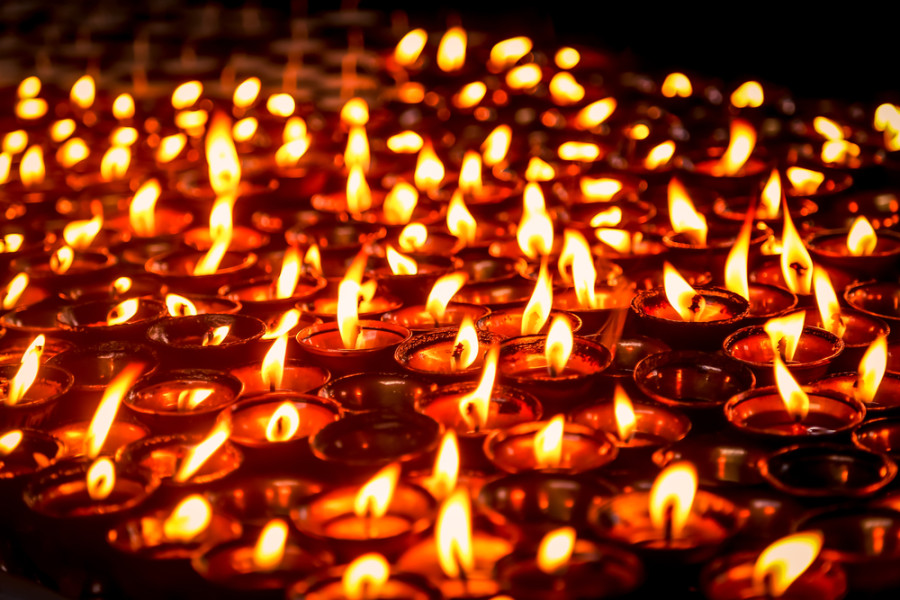Opinion
Music and mystery
Nasah Dyah is primarily regarded as the god of music, dance and performing arts.
Bigyesh Nepal
With the advent of summer, the Kathmandu Valley commences its series of religious festivals with tremendous devotion and the participation of the people. A myriad of gods and goddesses are worshipped and celebrated in a distinctive fashion. Chariot processions and masked dances are the usual ways of expressing devotion to the beloved deities among the valley’s Newars.
One common sight during such occasions is a group of boys, or even girls, beating big barrel-shaped drums suspended from a shoulder strap, parading down the street. Some might even see a group of men, mostly elders, sitting in a roadside shelter, singing devotional songs and praying to their gods. Amid the activity, one might not notice the presence of a deity who is neither pulled in a chariot nor installed in the form of an idol. He is venerated with the notes and rhythms of music or the graceful movements of a dance. He is known by many names, but is most popularly recognised by the name of Nasah Dyah.
Nasah Dyah, also known as Nrityanath or Nateshwara, is primarily regarded as the god of music, dance and performing arts. Many people also perceive him to be the god of charm as suggested by the literal meaning of the word 'nasah'. Hence, he is also revered as one who blesses people with charm and elegance, traits that are absolutely essential for those engaged in the performing arts.
Apart from the musical and charming qualities, there is also an enigmatic and mysterious side to him. Unlike the prevalent culture of worshipping idols, he is venerated in the form of triangular slits, one or three in number, made in the walls of houses or temples. These slits are rarely found in a sumptuous temple as is expected of a celebrated deity. Most of these small shrines are found in dark and small corners amid the narrow alleys of the traditional neighbourhoods.
In spite of being worshipped in an unconventional way, Nasah Dyah has never been regarded as an absolutely formless deity. There are quite a number of old illustrations and songs dedicated to him which piously portray the physical features that help to identify him as Shiva. In the illustrations, he is mostly portrayed as having three eyes and 18 arms holding different articles like a trident, skull and small double-headed drum. The potent Sanskrit hymns used in incantations and invocations also describe him as Shiva; these hymns are considered to be the most important and pristine depiction above all by both Hindus and Buddhists.
It is not uncommon to find some people who insist Nasah Dyah is a local god having no relation with other deities. Most of the proponents of this theory generally have two premises—the culture of worshipping slits and the conspicuous difference in the physical form from that of the Indian dancing Shiva, namely the famous Nataraja of India. Of the two ideas, the former is undoubtedly strong and self-evident, but the latter requires some meticulous study before imparting a conclusive justification. The major and most apparent difference between these two iconographies is the number of hands which might be presented as compelling evidence to segregate the two deities, however, there are other things to be considered as well.
One can find a copious amount of both similarities and differences in all of these depictions including the ones from Nepal, but the truth is that we may never hope to find an exhaustive resemblance, especially in cultures separated by distance and communication. By and large, the cult of venerating slits as the god of music and performing arts is truly an uncommon and mystical practice with conundrums that might not be unravelled easily. The only plausible explanation is to believe that Shiva, the lord of the occult, is depicted in accordance with the traditions of the society and culture that reveres him. And what better form would he take than Nasah Dyah in a place which was considered to be a Tantric stronghold not so far back in history?
Nepal is a musician and an independent music researcher.




 10.12°C Kathmandu
10.12°C Kathmandu










